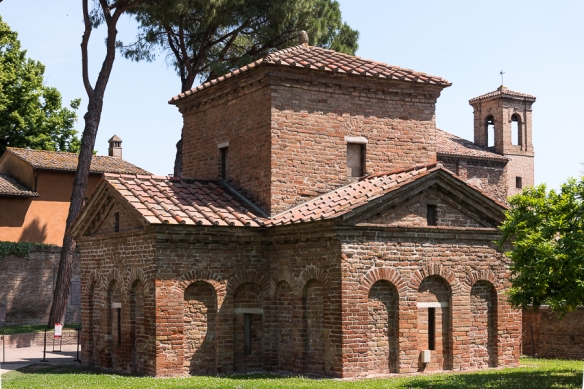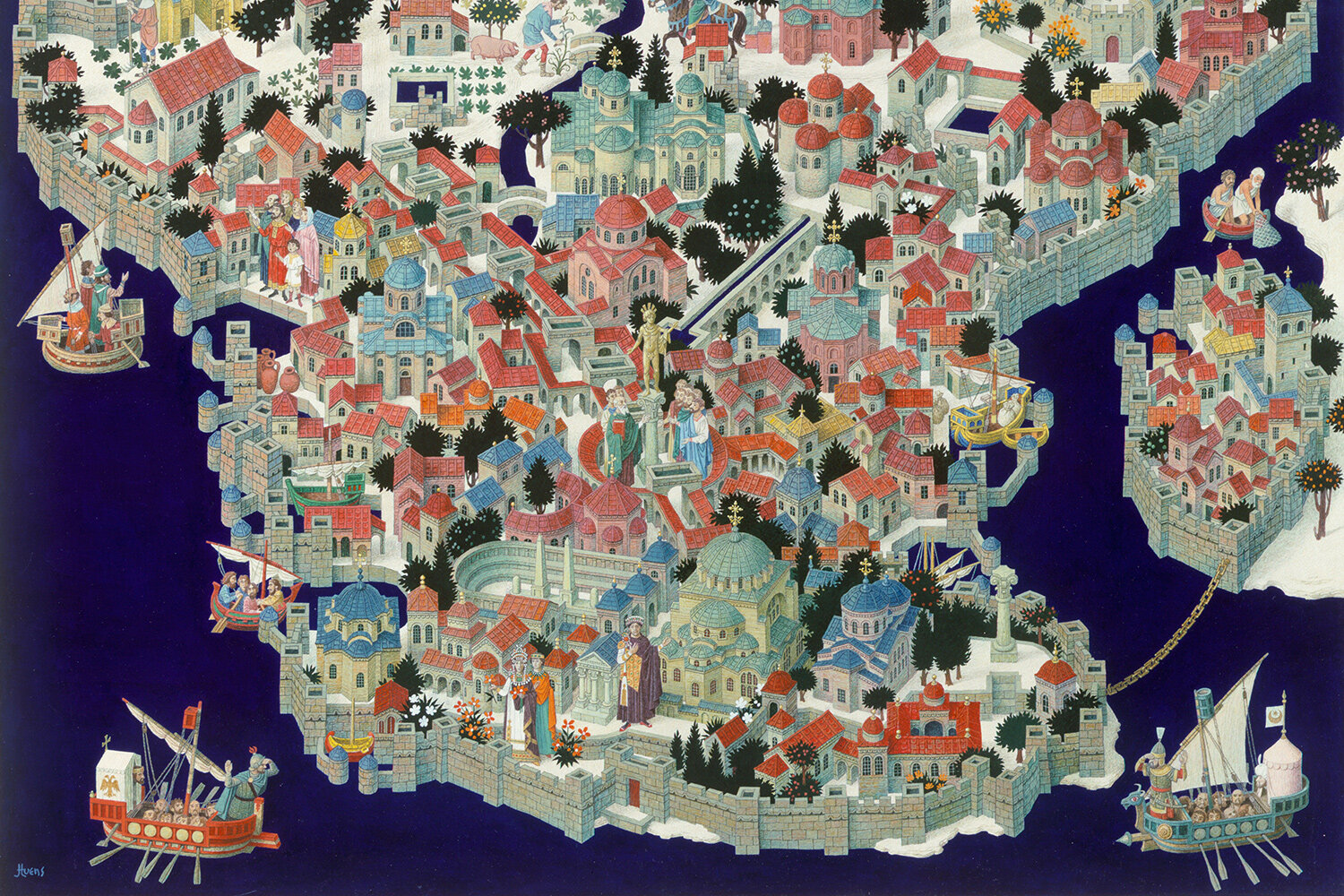
A few of the 39 participants of the 1921 Cairo Conference. Under the face of the Sphinx and from left to right: Winston Churchill, Gertrude Bell and T.E. Lawrence.
By Dale Debakcsy
First published in Women You Should Know
The art of Strenuous Living is one we usually associate with the generation of nervous over-achievers who grew up after the US Civil War, during the age that saw the American frontier officially disappear, and the cult of violent self-exertion find its most charismatic spokesperson in the barrel-chested polymath, Theodore Roosevelt. And yet, it was not Roosevelt, nor even any American, who pushed the idea of the Strenuous Life to its fullest potential in the bustling opening years of the Twentieth Century, but rather a rich Englishwoman, an alpine mountain climber and desert explorer, archaeologist and diplomat, author and linguist, who formed a nation and protected its historical treasures through the depth of her brilliance, the strength of her resolution, and the breadth of her sympathy.
She was Gertrude Bell (1868-1926), the privileged daughter of a well-established and massively influential iron-and-steel dynasty, and had she been made of less determined stuff her life might well have been one of steady and unchallenging leisure in the main with a side-line of progressive dabbling to cleanse the conscience and fill the hours between social visits. But Gertrude was a child of will, who had the great good fortune of possessing a father of deep affection and wide imagination. Father and daughter shared a life-long bond whereby each was All to the other, and Gertrude was given free reign to develop her difficult, adventurous side, much to the physical peril of her younger brother, who often injured himself trying to follow in his sister’s wake.
Gertrude was a willful child, a difficult child prone to physical exertion (especially horseback riding) and strange ideas (for a spell of time she would throw her dog into the pond every day because she found its struggles and panic comical), but more than anything she was a brilliant child lacking challenge. Her brain required education beyond the French and German and social “attainments” allotted her by her tolerant but traditional stepmother, and so in 1884 she was packed off to Queen’s College that she might, all hoped, find herself at last.
After two years at Queen’s, she began attending Lady Margaret Hall at Oxford University, and in just two years completed the history program there, and was the first woman to win a coveted 1st Class Honors in modern history. Having shown the magnitude of her intellectual mettle, Bell was thrust back upon a world that had no clear use for the gifts she had spent the last four years developing.
Fortunately, as a woman of means, Bell could afford to be supremely indifferent to the lack of official, remunerative positions available to her. She spent the next decade and a half in a dizzying whirl of travel, taking in Persia, Italy, Switzerland, Mexico, Japan, China, Greece, Lebanon, Palestine, Burma, Egypt, Algiers, and a rough dozen other countries besides. While in Switzerland, she developed a new passion that would alternate with her world travel as the central concern of her life – mountaineering.
Women mountaineers certainly existed in the late 19th and early 20th century, but Bell’s exploits in the Alps were to gain a particular renown, both for the number of first ascents she racked up in a relatively short number of years, and for the harrowing lengths she pushed herself and her guides to in the teeth of Nature’s most violent fits of temper. Clinging to sheer rock faces in snow and lightning for forty hours, leaping into the mist-shrouded unknown, shoving herself into small crevices so that her fellow climbers could use her body as a platform to just… reach…. the next wisp of a handhold, Bell’s exertions were legendary among climbers, and from them her fame spread to the wider world.
It was all very gratifying, but Bell found herself increasingly wondering, did it matter? She could spend months planning an ascent, and days performing it, and at the end feel very personally accomplished, but for all that time and effort, whose life had she really improved except her own? She had resources beyond those available to most, and so might be doing things that helped people less highly born than herself, but instead she had spent the better part of two decades in a series of rigorous and diverting amusements the benefits of which accrued to Bell and Bell alone. Surely she could not let her life be summed up with the Epitaph, “Gertrude Bell – she expensively entertained herself, then passed on.”
The chance to lash her powerful intellect and legendary physical fortitude to a cause beyond herself came in 1899 when she met archaeologist David Hogarth, who opened to her the world of Middle East antiquity. Already fluent in Persian, French, and German, she began in that year to study Arabic and Hebrew as well, and in 1900 she completed the first of her desert travels, a route that took her through Palestine, Lebanon, and Syria. This first excursion was an odd hybrid of amateur anthropology and tourism, but during it she began learning the rules of the desert, the social practices of the nomadic Bedouin, including their elaborate customs of mutual hospitality. By honoring these rules, she built up a steadily increasing catalogue of powerful friends among the wandering sheiks, warriors, and merchants of Mesopotamia, friends who regaled her with tales of the intricate relations between, and shifting power dynamics of, the tribes of the desert, information that would be central to her late-life role as an architect of the Iraqi state.
From 1900 to 1912, however, her focus was less on harnessing her deep local knowledge for the sake of politics, and more on develop her skills as an archaeologist, map-maker, and ethnographer in a land of bristling heat, brutal terrain, and unpredictable spurts of violence. She became a specialist in Byzantine architecture, and her 1907 explorations with Sir William Ramsay in Anatolia became the basis for her 1909 book The Thousand and One Churches, which is an important source for the understanding of Byzantine religious architecture to this day.
That year, after a 450 mile excursion to map sites along the Euphrates River, she discovered an incredibly well-preserved 8th century Abbasid fortress at Ukhaidir, and began to survey it using the techniques she had learned from the Royal Geographic Society in 1907. She wrote of her discovery in her account of her 1909/10 journeys, Amurath to Amurath, and then revisited the site in 1911 in preparation for a monograph devoted completely to its architectural nuances which was released in 1913 as The Palace and Mosque at Ukhaidir.
1911 was also the year she met a man whose fate was to intertwine with hers for the rest of her life, a budding young archaeologist by the name of T.E. Lawrence who history would later know by his more romantic moniker – Lawrence of Arabia. They shared a passion for Arabic culture and antiquities, and each in their own way would be a powerful force in the next decade in furthering the cause of Arabic independence, first from the rule of the Ottomans, and ultimately from the paternalist intentions of Europe.
In 1913 Bell completed her final, and most epic, desert excursion. 1,800 miles on camelback through the vast deserts of modern Saudi Arabia and Iraq with the impossible goal of seeing for herself the famed White City of Hayyil. Her path took her directly through the center of hotly contested territories, wherein she had to use every scrap of cultural knowledge she had accrued over the last decade to negotiate, bluff, and bully her way through the desert to her ultimate location. Critical water shortages, hostile tribes, and the ever shifting dunescape all did their utmost to ruin the expedition, but Bell pressed on, and her hired entourage, though grumbling, allowed their wills to bend to her forceful example. She achieved entry to Hayyil, where she would have been kept prisoner if not for her uncanny ability to turn people from all walks of life from suspicious antagonists to active and assiduous friends.
The journey completed at last, she returned home with maps and knowledge of Arabia that would soon prove themselves invaluable as Europe diplomatically bumbled its way into the First World War. With Turkey allying itself with Germany, the Middle East suddenly became an area of acute military importance which British intelligence knew hazardously little about. Who were the relevant powers in the area? Who did they support? What did they want? What could they be reasonably expected to do? Though most in British intelligence could not answer these questions, they were aware that Gertrude Bell was the one person in the Empire who could, and so in 1915 she was made the unprecedented offer of traveling to Cairo to begin work with British Intelligence to compile information and form a workable strategy for organizing Arabic resistance to Turkish rule.
Once arrived in Cairo, she naturally expanded her role from that of informal occasional adviser to resident expert and general policy coordinator. It was she who, when Indian officials expressed unease about the prospect of promoting Arabic revolution, traveled to India to smooth feathers and turn the Raj to her point of view. It was she who maintained direct relations with the relevant sheiks as a nascent Arabic nationalist movement formed in opposition to Turkish domination. And it was she who attended the Paris peace conferences after the war to fight strenuously for honoring the Allied promise of Arabic independence as against French delegates who were intent on setting up a mandate in Syria and British delegates engaged in creating a British mandate in Iraq and arbitrarily carving a Jewish homeland from Palestine.
At war’s end, Bell concentrated her efforts on promoting Faisal, a Sunni who could creditably claim descent from Mohammed and thereby at least partially address Shia concerns, as the best choice for leader of a newly unified Iraqi state. Through her efforts and advise, his cause was promoted, and through his charismatic if erratic leadership a nation was forged. For her part, Bell, now in her fifties, was given charge of the Iraq Museum in 1923, and threw herself into the task of recovering Iraq’s archaeological treasures while also promoting greater literacy in her role as president of the Baghdad Public Library.
She was one of King Faisal’s most trusted advisors and confidants, and a figure uniquely beloved by the people of Baghdad. While other British officials had prevaricated and argued for Iraq’s continued subservience to Britain, she had argued publicly and forcefully for their independence, and for the promotion of a larger Arabic state to include those lands which the French refused to relinquish. When her death came in 1926, the citizens of Baghdad lined the streets to pay respect to the passing body of this strange creature, this wealthy British atheist who had inexplicably but demonstrably given her life to the cause of poor Arabic Muslims, and to the preservation of a hard and vanishing way of life preserved in the rigors of her life, and the force of her words.
FURTHER READING: <a href="http://The Desert and the Sown: Travels in Palestine and Syria ” rel=”noopener” target=”_blank”>The Desert and the Sown (1907) was Bell’s first popular account of her travels in the desert, and is still an engaging read. <a href="http://Amurath to Amurath by Gertrude Lowthian Bell (2008-09-05)
” rel=”noopener” target=”_blank”>The Desert and the Sown (1907) was Bell’s first popular account of her travels in the desert, and is still an engaging read. <a href="http://Amurath to Amurath by Gertrude Lowthian Bell (2008-09-05) ” rel=”noopener” target=”_blank”>Amurath to Amurath (1911) is also a fascinating, if more technical, volume, and both are available in more modern editions so you don’t have to break the bank flagging down a vintage copy. There’s also a neat Penguin Classics edition, <a href="http://A Woman in Arabia: The Writings of the Queen of the Desert (Penguin Classics)
” rel=”noopener” target=”_blank”>Amurath to Amurath (1911) is also a fascinating, if more technical, volume, and both are available in more modern editions so you don’t have to break the bank flagging down a vintage copy. There’s also a neat Penguin Classics edition, <a href="http://A Woman in Arabia: The Writings of the Queen of the Desert (Penguin Classics) ” rel=”noopener” target=”_blank”>A Woman in Arabia: The Writings of the Queen of the Desert, that contains a good selection of her writings. For a survey of her life, I quite enjoyed Georgina Howell’s <a href="http://Gertrude Bell: Queen of the Desert, Shaper of Nations
” rel=”noopener” target=”_blank”>A Woman in Arabia: The Writings of the Queen of the Desert, that contains a good selection of her writings. For a survey of her life, I quite enjoyed Georgina Howell’s <a href="http://Gertrude Bell: Queen of the Desert, Shaper of Nations ” rel=”noopener” target=”_blank”>Gertrude Bell: Queen of the Desert, Shaper of Nations (2006), which is a bit light on the full substance of her architectural ideas, but makes up for it with a wonderful accounting of the politics of Arabia under the Ottomans, and Bell’s role in the creation of the Iraqi state.
” rel=”noopener” target=”_blank”>Gertrude Bell: Queen of the Desert, Shaper of Nations (2006), which is a bit light on the full substance of her architectural ideas, but makes up for it with a wonderful accounting of the politics of Arabia under the Ottomans, and Bell’s role in the creation of the Iraqi state.


















What Will Happen Now to Hagia Sophia’s Byzantine Mosaics?
The Mosaic of the Apse
Well. He’s done it. Turkey’s President, Recep Tayyip Erdoğan has pushed through his plans to annul the status of Hagia Sophia as a museum and turn it back into a mosque. We are all saddened. There is worldwide dismay and outrage. We can but hope that one day this decision will be revoked. In the meantime we must all be worrying that the beautiful mosaics will not be damaged. Greek Reporter and Hurriyet report that curtains may be installed to cover them during prayer.
We can have some idea based upon what happened at the smaller Hagia Sophia in the eastern port city of Trabzon as reported in the Economist:
Greek Reporter tells us more:
Following Turkey’s decision to annul the 1934 conversion of Constantinople’s Hagia Sophia into a museum, paving the way for its reconversion into a mosque, questions are asked about the fate of numerous mosaics that decorate several of its interior walls.
Many social media users are expressing horror at the thought of Hagia Sophia being turned into a mosque, with the ancient mosaics would be covered up — or even worse — removed.
Turkey’s daily Hurriyet reported that the mosaics will be covered up with specially-designed curtains during Muslim prayers and that visitors would be asked to take off their shoes before entering, as is the case with all mosques.
The original mosaics were not destroyed by the Ottoman conquerors but merely covered up when the city was captured in 1453. When Hagia Sophia was converted into a museum, they were uncovered so that visitors would enjoy them.
Some of the mosaics in Hagia Sophia are considered masterpieces, and they serve as a catalogue of Byzantine art. The motifs used in the creation of the mosaics were mostly imperial portraits and images of Christ.
Among them is the “Mosaic of the Apse,” completed during the 9th century, which decorates the half-dome located behind the altar. It is a representation of Virgin Mary sitting on a backless throne, with the baby Jesus seated on her lap.
It is set against a gleaming golden background to create a strong contrast with the dark color of her clothing.
he mosaic called the “Pantakrator” or “Almighty”
Another masterpiece is the “Pantakrator” mosaic decorated with the figure of Jesus, located on the top of the Imperial Gate. It shows Jesus blessing the world with his right hand and carrying the scriptures in his left hand.
The following Greek words are written on the Bible: “May Peace Be with You. I Am the Divine Light.”
Hagia Sophia’s “Deesis” Mosaic
The world famous “Deesis” mosaic, which is regarded as the beginning of a renaissance in Byzantine art, is located on the western wall of Hagia Sophia’s Northern Gallery.
John the Baptist is portrayed on the right side and the Virgin Mary on the left side of Jesus, who is in the middle in this important piece of Byzantine art.
Share this: